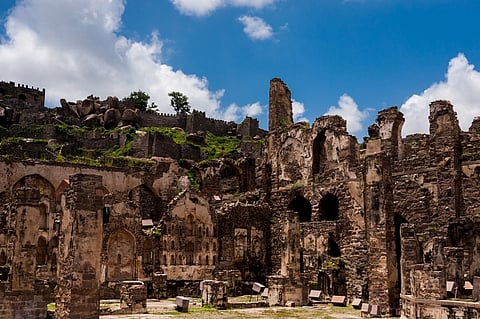

The Golconda Fort overlooking Hyderabad’s boulder-strewn (now not so much) landscape was originally a small mud fort believed to have been built in the 11th century by the Kakatiya rulers of Warangal. About 300 years later, the region briefly became a part the Delhi Sultanate. But soon, a commander named Alauddin Hassan Bahman Shah declared independence from the Sultanate, and founded the Bahmani kingdom that ruled much of the Deccan. About two centuries later, Sultan Quli Qutb-ul-Mulk, a Bahmani general, broke away and founded the Qutb Shahi Sultanate of Golconda. Most of what we see today of the fort, was built by the rulers of this dynasty.
The hill fort has three lines of fortification. The outermost surrounds what was the city of Golconda, and has eight entrance gates or darwazas. The part inside the second line is called the Bala Hisar. It is entered through an ornate gate followed by a porch, called the ‘clapping portico’ because a clap of the hands here can be heard all the way up in the innermost and highest point in the citadel. Most of the palaces are at the base of the hill. There’s a separate zenana or wing for the royal ladies. The palaces have decorative elements like water bodies and arched stucco niches on the walls. One of them, an open one whose roof is long gone, is believed to have been the grandest, and is now the venue for sound and light shows every evening. The complex also has audience halls where the Sultan could hear the grievances of his people.
(Solid granite defends the Golconda Fort)
On the way from the base to the top of the fort, one passes beautiful structures added during the reigns of various Sultans, like a beautiful armoury, a sarai or resting place for travellers, barracks for soldiers, offices for ministers, water reservoirs, small mosques etc.
(View of the ruins of the palace complex from above)
Most people ascending the fort stop to catch their breath, as well as the spectacular view, outside a prison called the Ramdas Bandikhana, where Bhakta Ramdas, the 17th century composer was imprisoned for 12 years. The ardent devotee of Lord Ram was sent to jail for using money collected as land revenues to build the famous Bhadrachalam temple. Legend has it that one night, two young men believed to be Lord Ram and his brother Lakshman visited the Sultan and returned the money. Ramdas was immediately freed, and the Sultan started the practice of sending gifts to the temple on Ram Navami every year.
(Steps leading to the granary)
The third line of fortification protects the innermost part of the fort. It roughly begins after an ambarkhana or granary. A little above the granary is a simple but stunning mosque named after Sultan Ibrahim Qutb Shah, the third ruler of the kingdom. Its minarets, perforated screens, arcaded balconies and stucco decorations exemplify the architecture from the Qutb Shahi era. The Mahakali temple is further up, and is where Bonalu celebrations in the city begin each year.
(Ruins of various structures)
The topmost structure in the fort is the Bala Hisar Baradari, commanding breathtaking views of the city. It is believed that it was used as a durbar hall.
(The Bala Hisar Baradari)
Towards the end of the 17th century, the Mughal army led by Aurangzeb laid siege to Golconda. The fortress was impregnable and had enough supplies to last a long time, but after eight months, a traitor opened one of the gates in the middle of the night, and let the Mughal forces in. The last Sultan Tana Shah was taken away in the morning, and imprisoned in the Daulatabad Fort. With that, Qutb Shahi rule in Golconda came to a sad end. Tana Shah was held captive for 13 long years, after which he died alone, far away from his family.
(The Bala Hisar Baradari towering over the other structures)
(The Bala Hisar Baradari towering over the other structures)